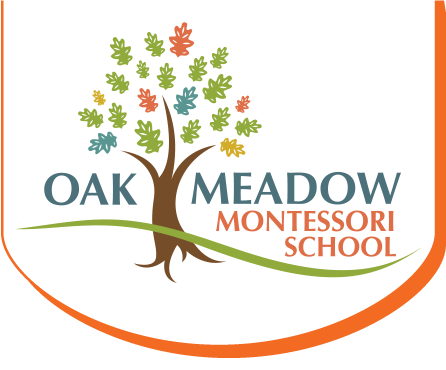Walk into an early childhood classroom at Oak Meadow School and it is a wonder to behold! Every child is self-directed, doing work that is highly meaningful to them. A child selects a learning activity from among the many shelves filled with all kinds of attractive and enriching materials. These materials will help them to unfold fascinating knowledge about math, language, science, geography, culture, and more. Sometimes the teacher suggests something that would be particularly helpful to a specific child. Other times, children select something that attracts their interest, or something that they want to do again so they can work up to their next level of personal mastery. Children spend time with each material, working through the learning routine modeled clearly and simply by the teacher. A child might work quietly on his or her own, or with another student or two. This kind of work continues through a long block of time each morning, with students remaining remarkably self-focused in the joy of learning.
 I had the opportunity this past week to spend some time in all three early childhood (Children’s House) classrooms, and in every instance I observed an incredible environment of animated, intrinsically-motivated learners. Here are just a few examples:
I had the opportunity this past week to spend some time in all three early childhood (Children’s House) classrooms, and in every instance I observed an incredible environment of animated, intrinsically-motivated learners. Here are just a few examples:
- A student is working on the “six chain” on his own. He is placing the correct number label after each chain of 6 beads: 6, 12, 18, etc. After he reaches the number thirty-six, or six chains of six, he records the multiples of six on paper. The teacher sits down next to the student, and the student explains what he has done. “Would you like to do this again, or would you like to do a new chain.” “A new chain,” replies the child. The child gets the ten chain from the cabinet, and the teacher and child stretch out the ten segments on a long mat on the floor. The teacher then folds each of the ten segments over each other line-by-line, forming a perfect square of 100 beads. During these early childhood years, this child is not only learning concepts of algebra and geometry, but he is absorbing math visually, in a way that he can understand, enjoy, and use with confidence.
- An older student is helping a younger student learn how to put a real flower into a vase. The teacher stands to the side observing, letting the older student mentor the younger one. The older student uses words to direct the younger student, but lets the younger one do all of the steps with very little assistance. First a spoon is used to put a small amount of plant food in the empty vase. Then a pitcher is used to pour water into the vase to just the right level. Scissors are used to cut a flower from a bunch of real flowers (in this step, the teacher assists the younger student), and the student then puts the flower into the vase. This young child learns a very deliberate sequence and uses practical skills to bring beauty to the classroom.
 Two girls are working with a material that sorts number pairs. They explore all of the number pairs that add up to the number 7, such as 1 and 6, 2 and 5, 5 and 2, 3 and 4, and so on. After they have finished, they show the teacher. “Okay let’s think. Is your work neat?” By making sure that the pair panels have been laid down accurately on the material, it will be possible for the students to determine if they have missed something. The girls straighten some of the number panels and realize they have missed one pair. “Put your heads together and I know you will figure out what’s missing,” the teacher tells them as she leaves to help another group. The girls look again and think through all of the possibilities. “Oh, we are missing 2 and 5,” one says, and they add that pair panel to the material. The grid they are using is self-correcting because it helps the girls see on their own if the number pairs correctly add up to 7, and if any number pairs are missing.
Two girls are working with a material that sorts number pairs. They explore all of the number pairs that add up to the number 7, such as 1 and 6, 2 and 5, 5 and 2, 3 and 4, and so on. After they have finished, they show the teacher. “Okay let’s think. Is your work neat?” By making sure that the pair panels have been laid down accurately on the material, it will be possible for the students to determine if they have missed something. The girls straighten some of the number panels and realize they have missed one pair. “Put your heads together and I know you will figure out what’s missing,” the teacher tells them as she leaves to help another group. The girls look again and think through all of the possibilities. “Oh, we are missing 2 and 5,” one says, and they add that pair panel to the material. The grid they are using is self-correcting because it helps the girls see on their own if the number pairs correctly add up to 7, and if any number pairs are missing.
- A child is working with a material that explains two specific landforms: a lake and an island. The teacher is working with the student. The lake has a depressed area surrounded by flat land. The island has a raised land area surrounded by a flat area. The student begins with the lake by pouring blue water from a pitcher into the depressed area, making a lake. The teacher asks, “Have you ever been to a lake? You can walk around it (he shows this on the material). You can live on the land near the lake. You can fish in the lake. You can go swimming in the lake. Do you like to swim? Or if you don’t like to swim, you can find a beach and just get your feet or ankles wet. Sometimes we might be able to see a lake from above when we are on a mountain, or in an airplane. Sometimes there are trees around the lake, or grasses.” The girl responds, “I was driving with my parents in the car, and we saw a lake from the car. It had trees all around it.” The teacher tells her, “why don’t you practice pouring the water into the lake, and then pouring it back into the pitcher. I will come back soon and we will talk about the island.” After the teacher and girl finish all of the activities about the lake and the island, the teacher points to the lake, and asks,”what do we call this?” The girl says, “a lake.” Later, this child will study much more complicated landforms.
- A boy is working on a material that illustrates subtraction and addition of large numbers. The
 teacher asks him to subtract 1,625 from 3,146. The material allows the student to concretely visualize large numbers in terms of thousands, hundreds, tens, and ones. It also helps the student understand how to borrow from the next column when a larger number is subtracted from a smaller number in any column. The teacher helps the student walk through the operation of borrowing, and then the student works independently to subtract 253 from 4,627 correctly. Based on working out this math problem with the material, the student is now ready to write the math problem as an equation on paper.
teacher asks him to subtract 1,625 from 3,146. The material allows the student to concretely visualize large numbers in terms of thousands, hundreds, tens, and ones. It also helps the student understand how to borrow from the next column when a larger number is subtracted from a smaller number in any column. The teacher helps the student walk through the operation of borrowing, and then the student works independently to subtract 253 from 4,627 correctly. Based on working out this math problem with the material, the student is now ready to write the math problem as an equation on paper.
There is so much happening here beyond what is seen at first. Let me share just a few of these factors:
First of all, the materials are incredibly effective for many reasons: they focus on one concept, allow the child to move from the simple to the complex and from the concrete to the abstract, allow for self-correction (without the teacher’s help), and ultimately help prepare the child for the next challenge they will face in the curriculum. In addition to the obvious cognitive benefits, the materials also support a child’s social-emotional development: they develop a sense of independence, foster a sense of order, develop self-discipline, lengthen concentration, build self-confidence, and increase the child’s repertoire of skills and concepts.
The other important factor in this unique learning environment is of course the teacher. A Montessori teacher is highly trained as an educator and in Montessori philosophy. What’s at the heart of a teacher’s work is a love for the child that is rooted in a deep conviction that within each child is the person he or she will become. In contrast to what happens in most schools, the job of the teacher in a Montessori school is not to pour information into the child, but instead to guide each child in a path that allows for self-discovery and maximization of each child’s unique strengths and possibilities. It’s impossible for a teacher to hold a limiting viewpoint about a child, because the teacher sees obstacles and challenges as yet another opportunity to discover the path that will enable a particular child to master essential skills in his or her own way.
In a world that increasingly recognizes that cognitive and social-emotional intelligence are interdependent, Oak Meadow is a school where this is being practiced each day in the learning experience of our students.





